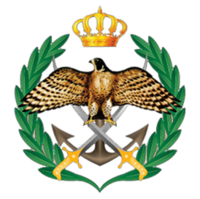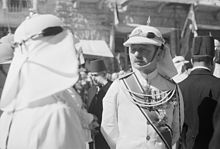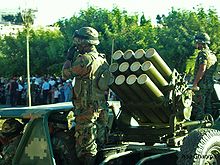- Jordanian Armed Forces
-
Jordanian Armed Forces
القوّات المسلّحة الاردنيّة


Emblem of the Jordanian Armed ForcesFounded October 1920 Current form March 1956 Service branches Jordanian Armed Forces
- Royal Jordanian Land Force
- Royal Naval Force

- Royal Jordanian Air Force

- Royal Special Forces

- His Majesty's Special Security
- Royal Maintenance Corps
- General Intelligence Dep.

- Public Security Directorate
- King Abdullah Design and Development Bureau
Leadership Commander King Abdullah II Manpower Military age 18-49 years old Conscription Suspended indefinitely in 1992; all members are regular volunteers. Active personnel 100,700 (2010 est.) Reserve personnel 65,000 (2010 est.) Expenditures Percent of GDP 6.7% (2010 est.) Industry Foreign suppliers  United States
United States
 Russia
Russia
 France
France
 Taiwan (small arms)
Taiwan (small arms)Annual imports $132 million Annual exports $72 million Related articles History Desert Force
Arab Legion
Transjordan Frontier ForceRanks Jordanian military ranks The Jordanian Armed Forces (القوات المسلحة الأردنية), also referred to as The Arab Army (الجيش العربي), with all of it branches, is under direct control of the King of Jordan. It is considered to be among the most professional in the region, and is seen as particularly well-trained and organized,[1] although lack of resources over the years has hampered the drive to modernize equipment.[2][3]
The current Chairman of the Joint Chiefs of Staff of the Jordanian Armed Forces is Lieutenant General Mashal Mohammad Al Zaben since February 23, 2010.
Contents
History
- Further information: Formation of the Jordanian Land Force.
- See Also: Arab Legion, Desert Force, Transjordan Frontier Force.

The first organized army in Jordan was established on 22nd of October 1920, and was named the Mobile Force, at the time it was 150 men strong under the command of the British Captain Frederick Peake. On its third anniversary, in October 1923, the now 1000 men force was renamed to the Arab Legion. In 1939, John Bagot Glubb, better known as Glubb Pasha, became the Legion's commander, and continued in office until the dismissal of British officers in March 1956. On 1st of April 1926, the Transjordan Frontier Force was formed, consisting of only 150 men and most of them were stationed along Transjordan's roads. The Jordanian Armed Forces was formed on 1 March 1956 by renaming the Arab Legion. Then-King Hussein wanted at the time to distance himself from the British and disprove the contention of Arab nationalists that John Glubb, the Arab Legion's commander, was the actual ruler of Jordan. Glubb was dismissed on the same date.
Objectives
The main objectives of the Jordanian Armed Forces are:
- Protect the Kingdom of Jordan borders from any invasion.
- Protect the people inside the Kingdom and their rights.
- Protect the King of Jordan.
Special forces
- Main Article: Royal Special Forces
Over the years, the development of the special forces has been particularly significant, enhancing the capability of the forces to react rapidly to threats to state security, as well as training special forces from the region and beyond.[4][5][6] Jordan has embarked on the installation of a sophisticated Command, Control, Communications, Computers, Intelligence, Surveillance, and Reconnaissance (C4ISR) system which is expected to enhance interoperability between the armed services and also between Jordanian and coalition forces as well as improving Jordan's air defense system.[2]
In order to better cope with a range of potential threats, Jordan has been re-organizing its armed forces. There has been a greater emphasis on rapid reaction and special forces.[1] The Special Operations Command (SOCOM), founded in the mid-1990s, has been focusing on both internal security in support of the Middle East peace process and border security. In the latter role, SOCOM gives particular attention to sophisticated smuggling operations on the Iraqi border and terrorist infiltration along the Syrian frontier. Jordanian forces have a particular focus on the sensitive frontier with the West Bank region.[2]
Peacekeeping
The Jordanian Armed Forces has been a strong supporter and participant of UN peacekeeping missions.[7][8][9][10] Jordan ranks third internationally in taking part in UN peacekeeping missions.[11] The size of the Jordanian participation in various areas of the United Nations peacekeeping troops and staff, hospital and international observers, is estimated to be 61,611 officers and men, starting in 1989 in Angola through the task of military observers and humanitarian security forces.[12] At the U.N. Copenhagen summit, Jordan was alone, out of more than 30 developing nations, in unveiling plans to help fight climate change, including upgrading its armed forces by 2020, an area usually overlooked in the global warming debate. The army will seek to upgrade engines and old vehicles and use energy saving technologies.[13][14]
International assistance
Jordan has dispatched several field hospitals to conflict zones and areas affected by natural disasters across the world such as Iraq, the West Bank, Lebanon, Afghanistan, Haiti, Indonesia, Congo, Liberia, Ethiopia, Eritrea, Sierra Leone, and Pakistan. The Kingdom's field hospitals extended some one million in the West Bank and 55,000 in Lebanon.[15] Jordan has committed nearly 600 health care practitioners to the medical assistance missions in Iraq and Afghanistan. A 50-bed Jordanian military hospital located in Masar-e Sharif, Afghanistan, cares for more than 650 patients a day, providing critical health care for thousands of Afghans who suffered neglect at the hands of the Taliban regime.[16] More than 500,000 patients have been treated at the Jordanian military hospital in Afghanistan.[16] In Iraq, a second Jordanian military hospital provides health services to Iraqis and serves as an ad hoc trauma center, treating patients wounded in terrorist attacks and moving them to Jordan or other locations. More than 4 million people have been treated in Jordan's military hospital in Iraq, and Jordanian military general surgeons have performed 1,638 surgeries.[16] In 24 Nov 2010, another Jordanian military field hospital (Gaza 11) arrived in the coastal territory of Gaza to replace (Gaza 10) whose tour of duty came to an end after treating 44,000 Palestinians and performing 720 minor and major surgeries since its inception in September 2010.[17][18]
Aside from saving lives by providing medical care, the Jordanians also have helped Iraqis protect their own lives by providing them with military and police training, and donated military and police equipment.[16] Jordanians have donated 250 armored personnel carriers to the Iraqi Ministry of Defense. The vehicles consisted of 50 Ukrainian-built BTR-94 armored personnel carriers, 100 British Spartans, and 100 American-made M113A1 armored personnel carriers, coalition officials said. Jordan also donated two C-130B Hercules transport aircraft to the Iraqi Air Force, as well as 16 UH-1H utility helicopters.[16]
Jordanians have helped train Iraqi security forces by hosting Iraqi police and border-enforcement training in Jordan, coalition officials said. Outside the Jordanian capital of Amman, the first all-female Iraqi army military police company was formed and trained by female Jordanian military personnel.[16] The Jordanian military opened its ranks to women in the 1960s. Royal Jordanian aircrews have trained some Iraqi air force pilots, and Jordanian noncommissioned officers helped train the Iraqi military's NCO corps in various locations in Iraq.[16]
References
- ^ a b http://www.socnet.com/archive/index.php/t-58075.html
- ^ a b c http://www.janes.com/extracts/extract/emedsu/jords100.html
- ^ http://hyperstealth.com/ka2/military/index.htm
- ^ http://www.globalresearch.ca/index.php?context=va&aid=19149
- ^ http://www.google.com/hostednews/afp/article/ALeqM5ijjb8xn57wfIS3SSG1it64ydGeZg
- ^ http://www.strategypage.com/htmw/htsf/20100514.aspx
- ^ http://en.ammonnews.net/article.aspx?articleNO=10786
- ^ http://www.potc.mil.jo/aboutus_all.shtm
- ^ http://www.jordanembassyus.org/060599002.htm
- ^ http://www.jordandirections.com/international/jordan-peacekeeping-personnel-in-darfur-0118-receive-medals-2010[dead link]
- ^ Bakhit highlighted that Jordan ranks third internationally in taking part in UN peacekeeping missions.
- ^ http://en.ammonnews.net/article.aspx?articleNO=6047
- ^ http://www.alertnet.org/thenews/newsdesk/LDE61H0TH.htm[dead link]
- ^ http://thestar.com.my/news/story.asp?file=/2010/2/19/worldupdates/2010-02-19T162918Z_01_NOOTR_RTRMDNC_0_-463064-1&sec=Worldupdates[dead link]
- ^ http://www.jordanembassyus.org/09262007004.htm
- ^ a b c d e f g "DefenseLink News Article: Jordanian Military Helps Its Neighbors". Defenselink.mil. http://www.defenselink.mil/news/newsarticle.aspx?id=14978. Retrieved 2010-07-05.
- ^ http://www.zawya.com/Story.cfm/sidZAWYA20101125062736/Jordanian%20military%20field%20hospital%20arrives%20in%20Gaza
- ^ http://en.ammonnews.net/article.aspx?articleNO=10949
External links
Forces History Other Ministry of Interior · Public Security Directorate · Jordanian National Police · General Intelligence Directorate · General Directorate of Gendarmerie · Civil Defense Directorate · MilitaryMilitaries of Asia Sovereign
states- Afghanistan
- Armenia
- Azerbaijan
- Bahrain
- Bangladesh
- Bhutan
- Brunei
- Burma (Myanmar)
- Cambodia
- People's Republic of China
- Cyprus
- East Timor (Timor-Leste)
- Egypt
- Georgia
- India
- Indonesia
- Iran
- Iraq
- Israel
- Japan
- Jordan
- Kazakhstan
- North Korea
- South Korea
- Kuwait
- Kyrgyzstan
- Laos
- Lebanon
- Malaysia
- Maldives
- Mongolia
- Nepal
- Oman
- Pakistan
- Philippines
- Qatar
- Russia
- Saudi Arabia
- Singapore
- Sri Lanka
- Syria
- Tajikistan
- Thailand
- Turkey
- Turkmenistan
- United Arab Emirates
- Uzbekistan
- Vietnam
- Yemen
States with limited
recognition- Abkhazia
- Nagorno-Karabakh
- Northern Cyprus
- Palestine
- Republic of China (Taiwan)
- South Ossetia
Dependencies and
other territories- Christmas Island
- Cocos (Keeling) Islands
- Hong Kong
- Macau
Categories:- Military of Jordan
Wikimedia Foundation. 2010.


